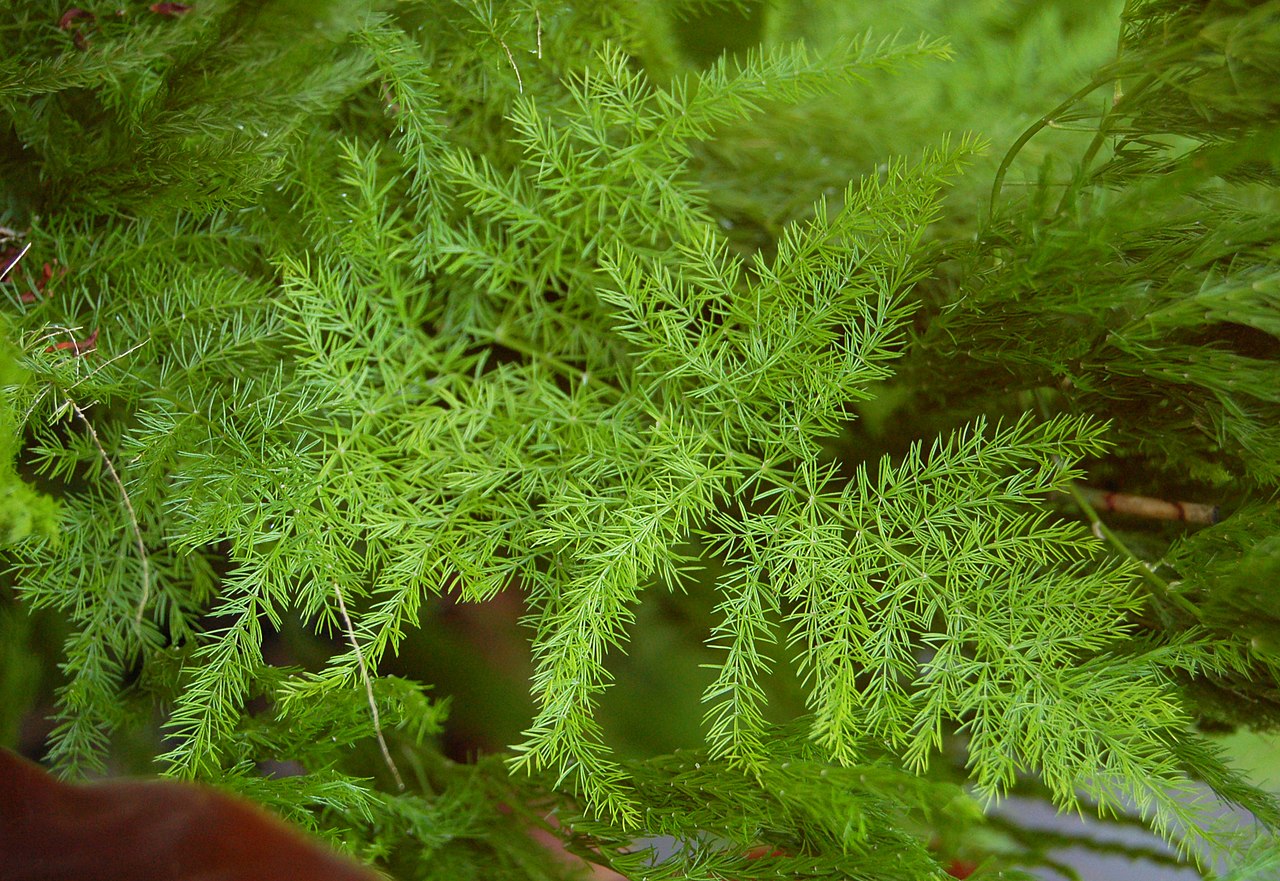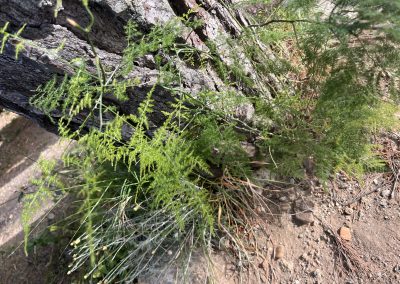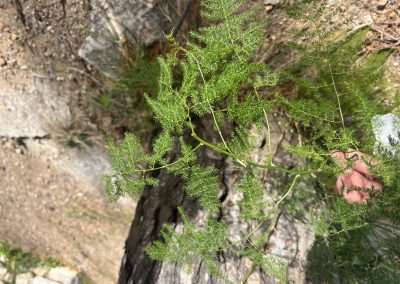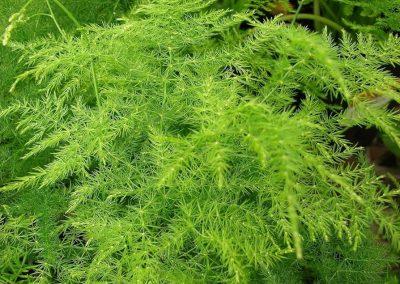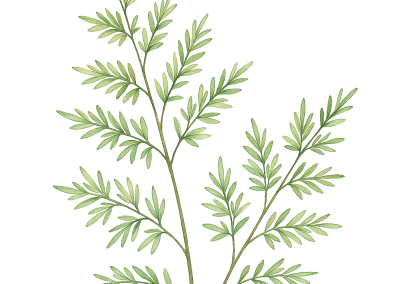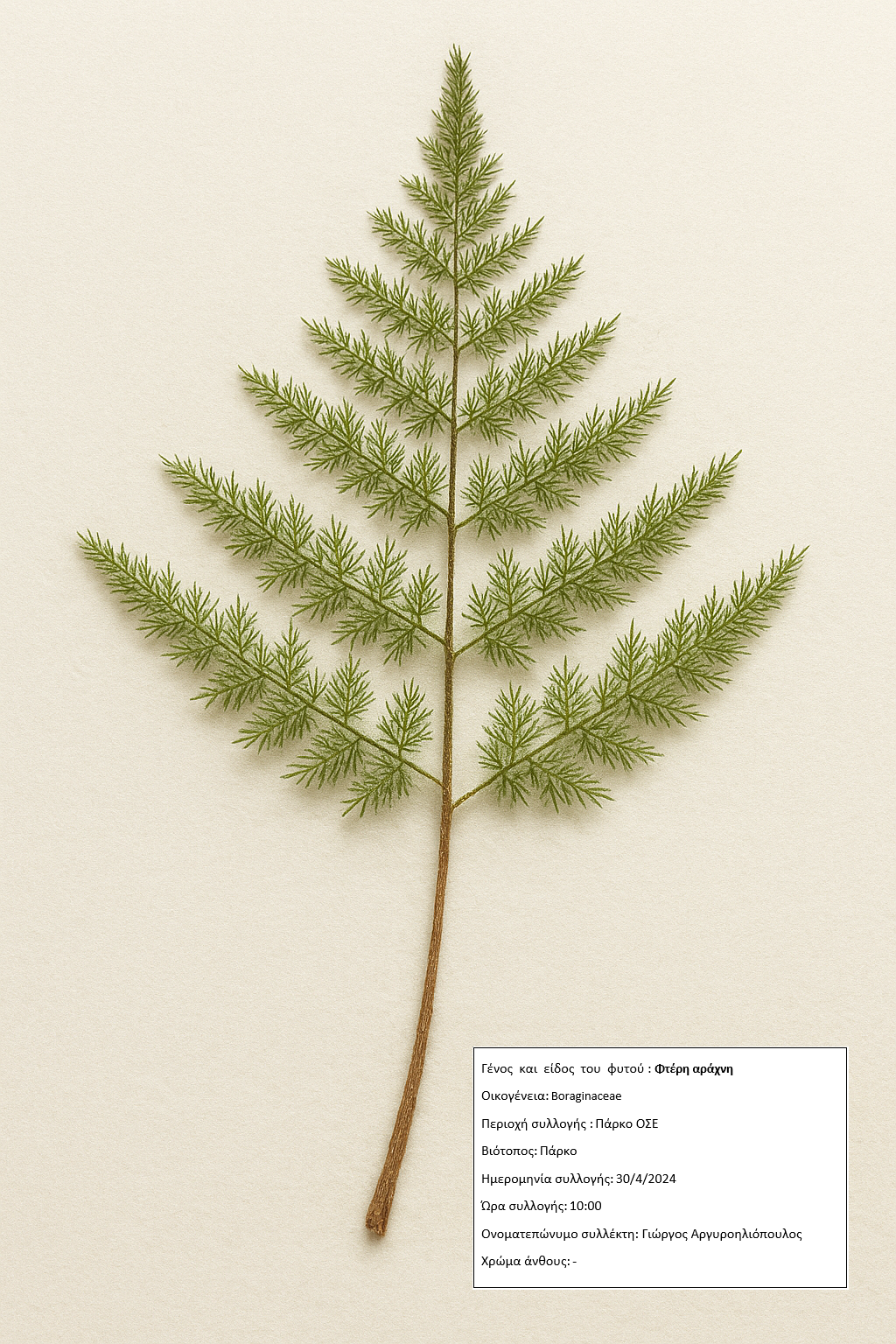Asparagus setaceus
Scientific description
Scientific name: Asparagus setaceus
Greek name: fern spider
Kingdom: Plantae
Clade: Tracheophytes
Clade: Vascular Sperm
Clade: Monocots
Clade: Clades
Family: Asparagaceae
Subfamily: Asparagoideae
Genus: Asparagus
Species: Asparagus setaceus
Origin of the name:
The Latin adjective setaceus means "hairy". Despite its common name, the plant is not a true fern, but has fern-like leaves.
Origin:
East and southern Africa.
Description:
Leaves are leaf-shaped branches up to 7 mm long and 0.1 mm in diameter, arising in clusters of up to 15 from the stem, producing fine, pale green fern-like foliage. Sharp, spiny spines appear on the stem. Small greenish-white bell-shaped flowers appear from spring to autumn, 0.4 cm long, followed by small green berries, turning black at maturity. Reported to be toxic if eaten, causing diarrhoea and abdominal pain.
Ecology:
Cultivated in Greece as an ornamental. In some areas introduced, it can become invasive. Grown for gardens, containers, or as house plant. Attractive foliage used in flower arrangements. Hardy to 1 °C (34 °F), does not tolerate freezing; in temperate zones usually grown indoors in bright, indirect light.
Propagation:
By seed in autumn or early spring.
Use:
Ornamental, also filters toxins and provides clean air indoors.
Επιστημονική ονομασία: Asparagus setaceus
Ελληνική ονομασία: φτέρη αράχνη
Βασίλειο: Plantae
Clade: Τραχειόφυτα
Clade: Αγγειόσπερμα
Clade: Μονοκοτάκια
Σειρά: Σπαράγαλες
Οικογένεια: Asparagaceae
Υποοικογένεια: Asparagoideae
Γένος: Σπαράγγι
Είδος: Asparagus setaceus
Καταγωγή ονόματος:
Το λατινικό επίθετο setaceus σημαίνει «τριχωτός». Παρά την κοινή του ονομασία, το φυτό δεν είναι αληθινή φτέρη, αλλά έχει φύλλα που μοιάζουν με φτέρη.
Καταγωγή:
Ανατολική και Νότια Αφρική.
Περιγραφή:
Φύλλα είναι φυλλόμορφες κλαδίδες μήκους έως 7 mm και διαμέτρου 0,1 mm, που εμφανίζονται σε συστάδες έως 15 από το στέλεχος, δημιουργώντας λεπτό, απαλό πράσινο φύλλωμα σαν φτέρη. Αιχμηρά αγκάθια στο στέλεχος. Μικρά πράσινο-λευκά άνθη, μήκους 0,4 cm, εμφανίζονται από άνοιξη έως φθινόπωρο, ακολουθούμενα από μικρά πράσινα μούρα που μαυρίζουν με ωρίμανση. Τοξικά αν καταναλωθούν.
Οικολογία:
Στην Ελλάδα καλλιεργείται ως καλλωπιστικό. Σε ορισμένα μέρη μπορεί να γίνει χωροκατακτητικό. Καλλιεργείται σε κήπους, δοχεία ή ως φυτό σπιτιού. Φύλλωμα χρησιμοποιείται σε συνθέσεις λουλουδιών. Ανθεκτικό έως 1 °C, δεν αντέχει πάγο. Σε εύκρατες ζώνες καλλιεργείται σε εσωτερικούς χώρους με έντονο, έμμεσο φως.
Πολλαπλασιασμός:
Με σπόρους το φθινόπωρο ή αρχή άνοιξης.
Χρήση:
Καλλωπιστικό, φιλτράρει τοξίνες και καθαρίζει τον αέρα.
Nom scientifique : Asparagus setaceus
Nom grec : fougère araignée
Règne : Plantae
Clade : Trachéophytes
Clade : Sperme vasculaire
Clade : Monocots
Clade : Clades
Famille : Asparagaceae
Sous-famille : Asparagoideae
Genre : Asparagus
Espèce : Asparagus setaceus
Origine du nom :
L'adjectif latin setaceus signifie « poilu ». Malgré son nom commun, la plante n'est pas une vraie fougère mais a des feuilles semblables à celle-ci.
Origine :
Afrique de l'Est et du Sud.
Description :
Feuilles en branches en forme de feuille jusqu'à 7 mm de long et 0,1 mm de diamètre, en grappes de 15 sur la tige, produisant un feuillage fin, vert pâle, semblable à une fougère. Épines sur la tige. Petites fleurs blanc-verdâtre en clochettes de 0,4 cm apparaissent du printemps à l'automne, suivies de petites baies vertes, devenant noires à maturité. Toxiques si consommées.
Écologie :
Cultivée en Grèce comme plante ornementale. Dans certaines régions, elle peut devenir envahissante. Plantée dans jardins, pots ou en intérieur. Feuillage utilisé en compositions florales. Résistante jusqu'à 1 °C, ne tolère pas le gel. En zones tempérées, cultivée à l'intérieur en lumière indirecte.
Propagation :
Par semis en automne ou début du printemps.
Utilisation :
Ornementale, filtre également les toxines et purifie l'air.
Denumire științifică: Asparagus setaceus
Nume grecesc: păianjen de ferigă
Regn: Plantae
Cladă: Tracheophytes
Cladă: Spermatozoid vascular
Cladă: Monocotiledonate
Cladă: Clade
Familie: Asparagaceae
Subfamilie: Asparagoideae
Gen: Asparagus
Specie: Asparagus setaceus
Origine a numelui:
Adjectivul latin setaceus înseamnă „păros”. În ciuda numelui comun, planta nu este o ferigă adevărată, ci are frunze asemănătoare ferigilor.
Origine:
Africa de Est și de Sud.
Descriere:
Frunze ca ramuri în formă de frunze de până la 7 mm lungime și 0,1 mm diametru, în ciorchini de până la 15 pe tulpină, producând frunziș fin, verde pal, asemănător ferigii. Spini ascuțiți pe tulpină. Florile alb-verzui 0,4 cm apar primăvară-toamnă, urmate de fructe mici verzi care devin negre la maturitate. Toxice dacă sunt consumate.
Ecologie:
Cultivată ca plantă ornamentală în Grecia. Poate deveni invazivă în unele locuri. Folosită în grădini, ghivece sau ca plantă de apartament. Frunziș folosit în aranjamente florale. Rezistentă până la 1 °C, nu tolerează înghețul; în zone temperate se cultivă în interior cu lumină indirectă.
Înmulțire:
Prin semințe în toamnă sau la începutul primăverii.
Utilizare:
Ornamentală, filtrează toxine și purifică aerul din încăpere.
Creative writing inspired by Asparagus setaceus
Asparagus setaceus — Spider Fern
Long ago, there lived a young weaver named Arachne, renowned for her incredible skill at the loom. However, Arachne was proud of her craft and often boasted that she could surpass even the goddess Athena, the patron of arts and crafts. Her weavings were so fine and beautiful that people believed she was blessed by the Muses.
This angered Athena, who decided to challenge Arachne to a weaving contest. Fearlessly, Arachne accepted, and the two began to weave. Athena wove a magnificent tapestry depicting the strength and wisdom of the gods, while Arachne wove a scene mocking their weaknesses.
Although Arachne's weaving was perfect, Athena was angry at her insult. She punished her by turning her into a spider, condemning her to weave her web forever. However, the goddess did not completely deprive her of the gift of art.
There, under the leaves of a fern, a plant was born with thin, spidery branches that resembled the webs that the Spider wove. The plant was called the spider fern, and people believed that the soul of the spider lived inside it, weaving invisible webs between its branches, as a symbol of the eternal art and patience that every creator needs.


